The Congo is home to a wide variety of unique bird species, from the colourful masked weaver to the majestic African fish eagle. With its dense and varied rainforest habitats, the Congo is a paradise for bird-watchers, and a haven for a range of species that are found nowhere else in the world.
These birds are a major part of the Congo’s diverse ecological system, and their presence helps to maintain the balance of the Congo’s natural environment.
1. Grey Parrot
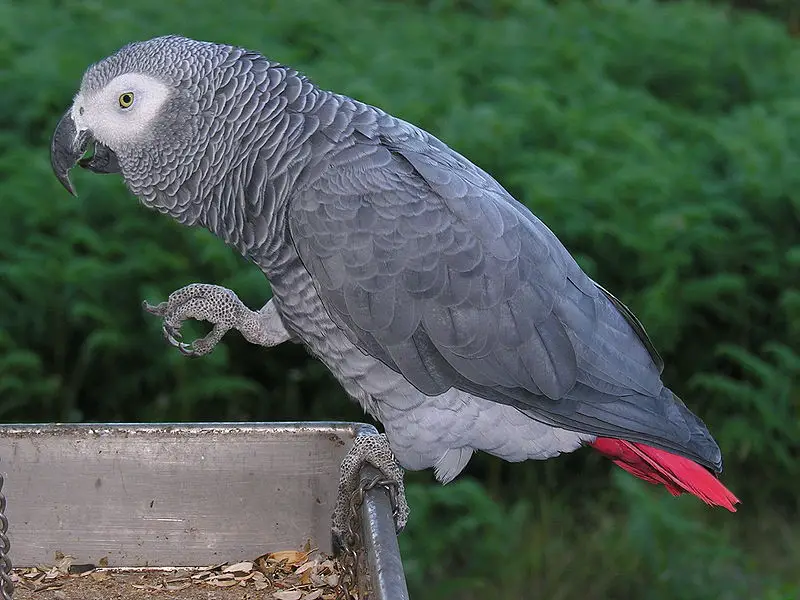
The Grey Parrot, also known as the Congo grey parrot, is a species of Old World parrots belonging to the family Psittacidae.
It was formally described by Swedish naturalist Carl Linnaeus in 1758.
This bird has an ash-grey plumage with bright red tail feathers and white markings around its eyes and beak.
They are very intelligent birds that can mimic human speech and understand basic commands.
Their diet consists mainly of fruits, nuts, seeds, vegetables and insects found in their native African habitat or other tropical regions they inhabit such as rainforests or woodlands.
Grey parrots have become popular pets due to their intelligence and ability to learn complex behaviors like talking back when spoken too.Scientific classification:
| Kingdom | Animalia |
| Phylum | Chordata |
| Class | Aves |
| Order | Psittaciformes |
| Family | Psittacidae |
| Genus | Psittacus |
| Species | P. erithacus |
Also Featured In: Birds That Live in the Jungle, Aviary Birds You Should Know
2. Turaco
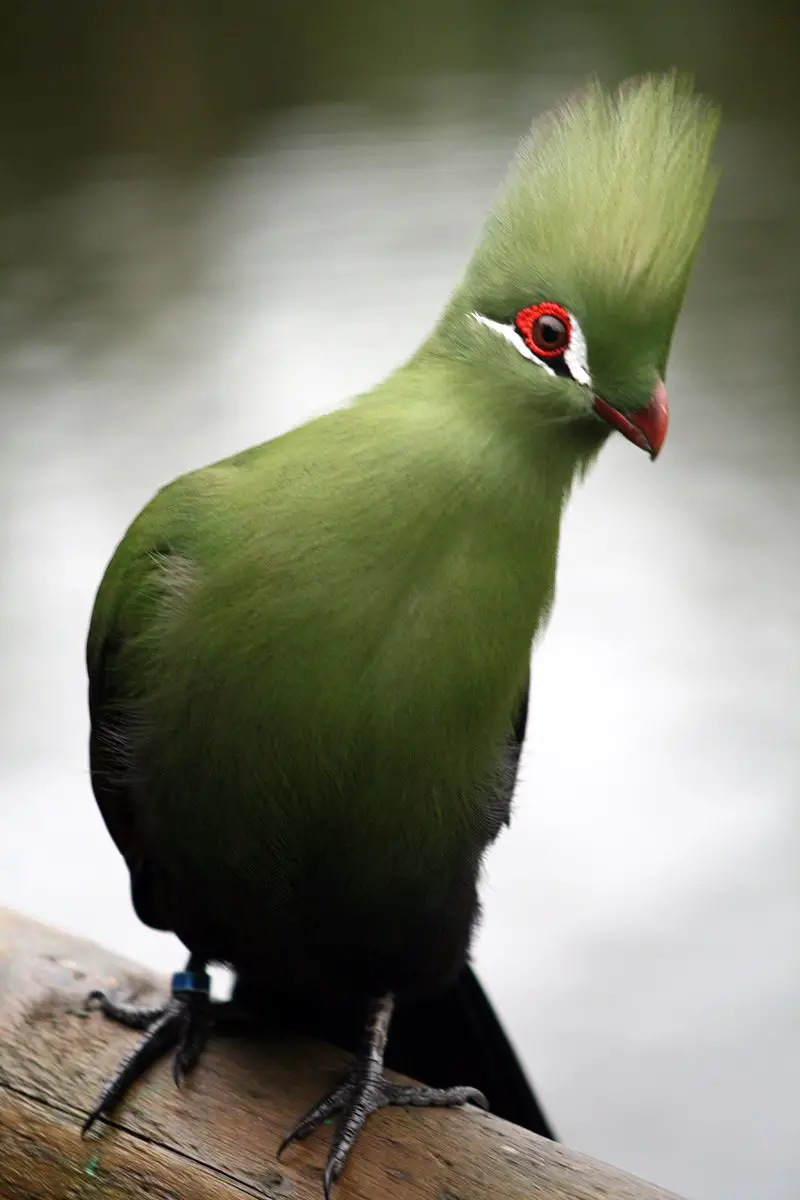
Turacos are a unique bird family that inhabit tropical and subtropical regions of Africa. They are also known as “banana-eaters” or “loeries” in southern Africa, due to their diet which consists mostly of fruit such as plantains.
These birds have an interesting semi-zygodactylous foot structure – the fourth toe can be switched back and forth while the second and third toes remain conjoined.
Turacos come in different sizes depending on species but they all generally boast bright colors like green, blue, purple or red feathers with vibrant yellow eyes.
In addition to being beautiful creatures, these birds make loud calls during mating season which makes them even more special.Scientific classification:
| Kingdom | Animalia |
| Phylum | Chordata |
| Class | Aves |
| Clade | Otidimorphae |
| Order | Musophagiformes Seebohm, 1890 |
| Family | Musophagidae Lesson, 1828 |
3. Hamerkop
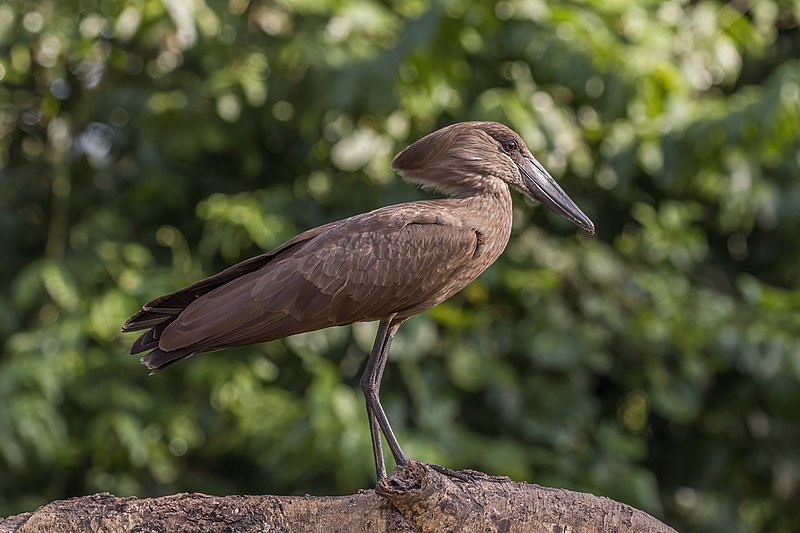
The Hamerkop is a unique wading bird found across sub-Saharan Africa and as far east as India.
It has an unmistakable silhouette, with its long bill topped by a crest at the back of its head that gives it the look of a hammerhead shark.
Its plumage consists mainly of browns and greys, providing excellent camouflage in reed beds.
The species was once classified alongside storks but is now believed to be closely related to pelicans and shoebills instead.
This medium-sized bird feeds on insects, fish, frogs or small reptiles which it captures from shallow water or plucks from trees near bodies of water.
Despite being considered ‘unlucky’ by some cultures due to superstition surrounding their appearance they are actually quite important for controlling populations of certain pests.Scientific classification:
| Kingdom | Animalia |
| Phylum | Chordata |
| Class | Aves |
| Order | Pelecaniformes |
| Family | Scopidae |
| Genus | Scopus |
| Species | S. umbretta |
4. Congo Peafowl
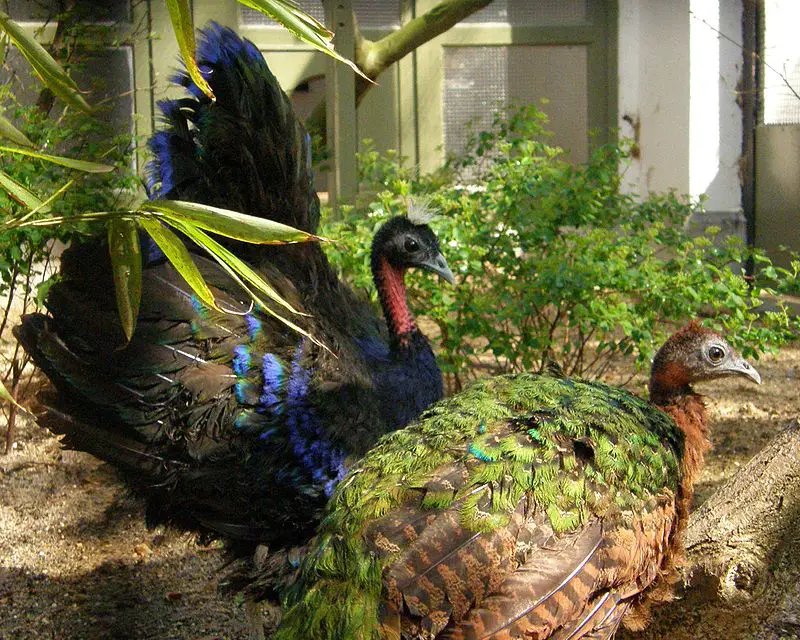
The Congo Peafowl is a species of peafowl native to the Congo Basin in Africa. It has an impressive, long reddish-brown feather that can be found on Congolese headdresses.
The bird itself is listed as Vulnerable on IUCN Red List due to habitat loss and hunting for its feathers, which are used for decoration or religious ceremonies.
To protect this beautiful animal from extinction conservation efforts such as education about their importance must be done.
In addition, legal protection should also be implemented so that these birds will not face any more persecution and danger of being wiped out from our planet forever.Scientific classification:
| Kingdom | Animalia |
| Phylum | Chordata |
| Class | Aves |
| Order | Galliformes |
| Family | Phasianidae |
| Tribe | Pavonini |
| Genus | Afropavo Chapin, 1936 |
| Species | A. congensis |
5. Red-Billed Dwarf Hornbill
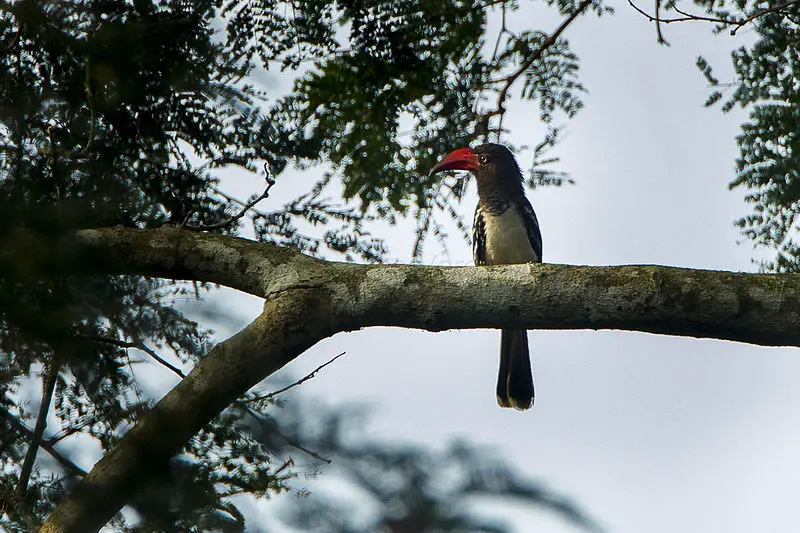
The red-billed dwarf hornbill is a species of bird found in the African tropical rainforest. It belongs to the Bucerotidae family and has a striking appearance, with its bright red bill contrasting against mainly black feathers.
Its wings are long and pointed, helping it to fly through dense vegetation quickly. The diet of this small hornbill consists mostly of insects, fruit and seeds.
They live both solitarily or in pairs but may form larger flocks during breeding season when they search for mates together.
These birds build their nests high up into tree hollows where they lay their eggs before taking turns incubating them until hatching occurs – an amazing example of teamwork.
Red-billed dwarf hornbills really are remarkable creatures that help keep natural ecosystems balanced throughout Africa’s lush forests; we should all do our part in protecting these majestic animals from extinction so future generations can appreciate them too.Scientific classification:
| Kingdom | Animalia |
| Phylum | Chordata |
| Class | Aves |
| Order | Bucerotiformes |
| Family | Bucerotidae |
| Genus | Lophoceros |
| Species | L. camurus |
6. Red-Backed Shrike
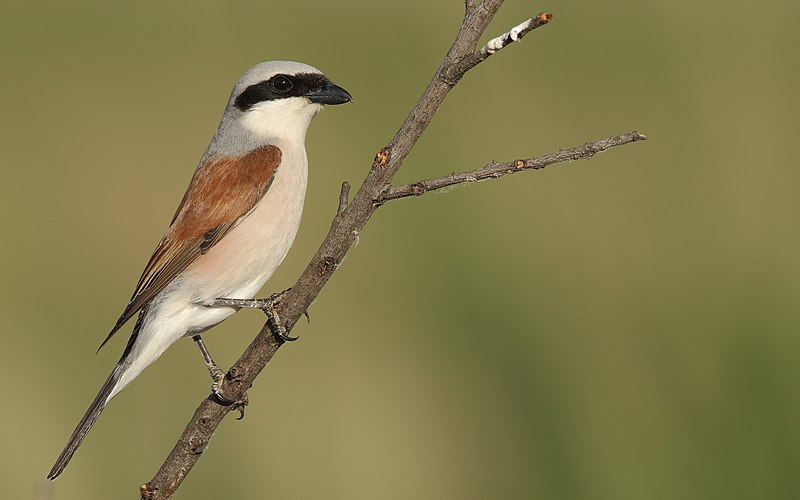
The Red-backed Shrike is a beautiful member of the shrike family, found in western Europe and central Russia. It is easily identified by its gray mantle, black wings with white spots and red back.
In summer it migrates to eastern tropical Africa or southern Africa where they overwinter.
This bird feeds mainly on insects but also eats small mammals, reptiles and other birds as well as fruit occasionally.
They are known for their hunting techniques which include perching high up in trees then diving down onto their prey below them before returning to eat it at leisure elsewhere.
The Red-backed Shrike is an impressive sight that lives both in our gardens and far away places.Scientific classification:
| Kingdom | Animalia |
| Phylum | Chordata |
| Class | Aves |
| Order | Passeriformes |
| Family | Laniidae |
| Genus | Lanius |
| Species | L. collurio |
7. Guinea Turaco
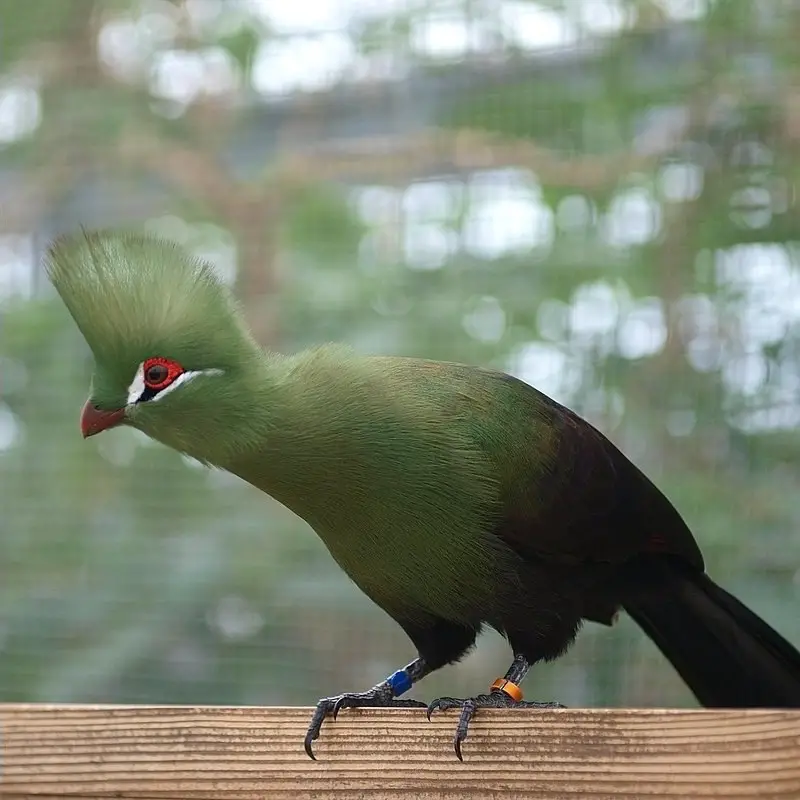
The Guinea turaco is a stunning bird belonging to the otidimorphae family. It has bright green plumage with striking shades of red and blue on its wings, neck and head.
The most distinguishing feature is their long tail which can be up to 25 cm in length.
They are native to West Africa where they inhabit tropical rain forests, woodlands and savannas near water sources or wet areas nearby rivers.
These birds feed mainly on fruits but will also eat insects as well as small lizards or snails when available.
When disturbed or threatened by predators they make loud alarm calls like yelping noises that help alert other members of their flock for safety in numbers against potential danger from predators such as snakes and large mammals like monkeys; proving themselves an essential part of any healthy ecosystem.Scientific classification:
| Kingdom | Animalia |
| Phylum | Chordata |
| Class | Aves |
| Order | Musophagiformes |
| Family | Musophagidae |
| Genus | Tauraco |
| Species | T. persa |
8. Chestnut Wattle-Eye
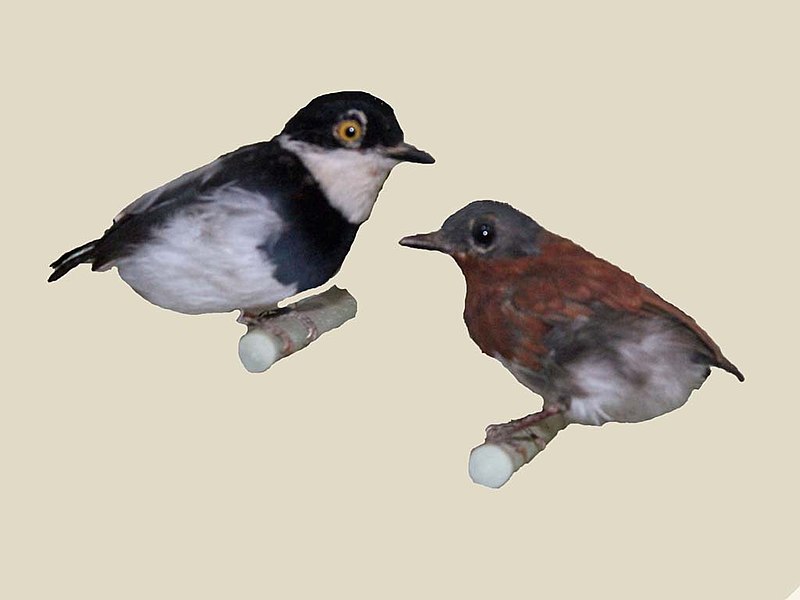
The Chestnut Wattle-eye is a species of bird found in Central and West Africa, from Angola to Zambia. It inhabits moist lowland forests as well as subtropical swamps and woodlands.
This small passerine has distinctive black eyes bordered by white, an olive green back with yellow edging on the wings, chestnut underparts and a bright red head patch.
Its diet consists mostly of insects like flies, moths and beetles which it catches in flight or gleans from foliage.
The Chestnut Wattle-eye also sometimes feeds on fruit while perched high up in trees – often seen alone but occasionally forming mixed flocks with other birds such as sunbirds or weavers.
With its vivid colours this unique little bird brings vibrancy to the African forest canopy.Scientific classification:
| Kingdom | Animalia |
| Phylum | Chordata |
| Class | Aves |
| Order | Passeriformes |
| Family | Platysteiridae |
| Genus | Platysteira |
| Species | P. castanea |
9. African Openbill
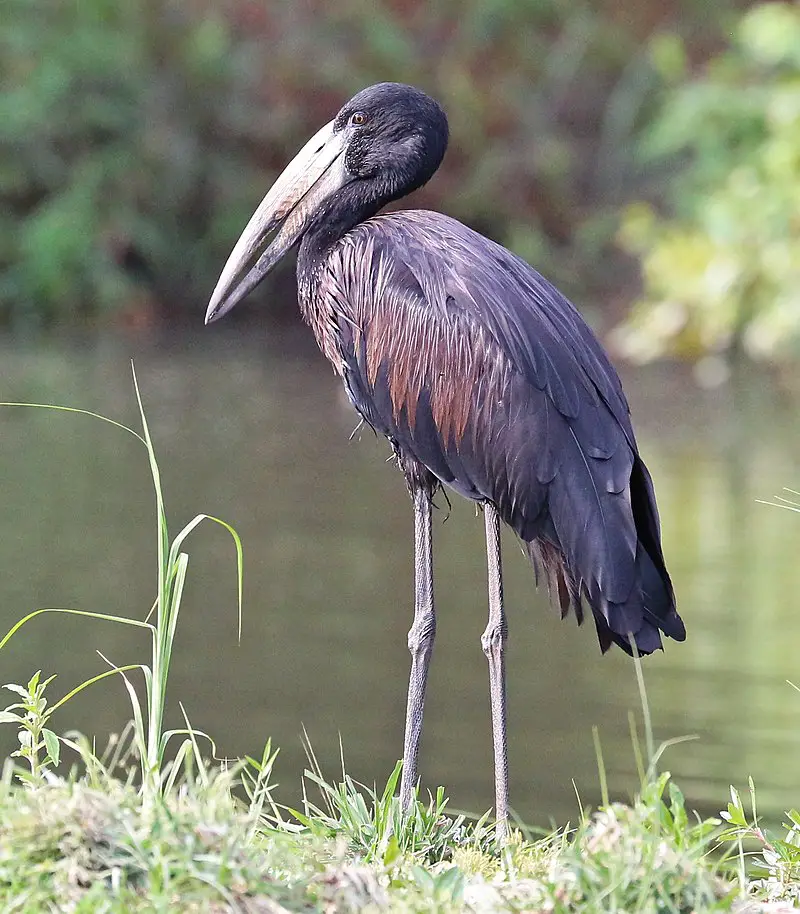
The African openbill is a species of stork found in Sub-Saharan Africa and western Madagascar.
It has a patchy distribution but is generally considered to be common or locally abundant, with two subspecies – A. l. lamelligerus on the continent and A. l. batesi in some parts of Madagascar’s west coast region.
This bird stands up to 75 cm tall and has an impressive bill that looks like it’s been cut down the middle when opened wide.
Its black feathers are contrasted by bright yellow legs, pinkish red eyes, and white wing tips which make it easily recognizable from other species of birds.
It feeds mainly on snails found amongst aquatic vegetation so can often be seen wading through shallow waters looking for food as well as perched atop trees scanning its surroundings for prey items.Scientific classification:
| Kingdom | Animalia |
| Phylum | Chordata |
| Class | Aves |
| Order | Ciconiiformes |
| Family | Ciconiidae |
| Genus | Anastomus |
| Species | A. lamelligerus |
10. Saddle-Billed Stork
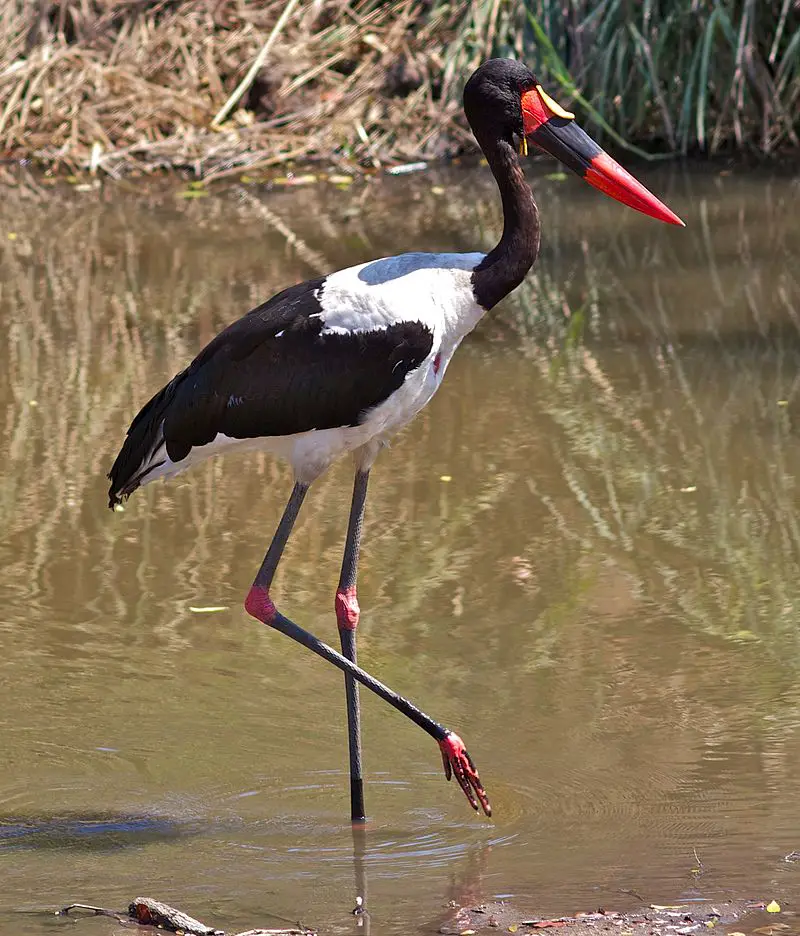
The Saddle-billed Stork is a large wading bird from the stork family, Ciconiidae. It can be found in sub-Saharan Africa and some parts of western Africa.
This majestic bird stands out with its striking features – it has an impressive bill that looks like a saddle and bright red legs which contrast against its white plumage on top.
The Saddle-billed Stork’s diet consists mostly of fish, frogs, aquatic invertebrates as well as small reptiles or mammals they come across while scavenging for food in wetland areas.
Sadly, this species is considered endangered in South Africa due to habitat loss and degradation caused by human activities such as drainage projects and agricultural expansion.
We must take action to protect these beautiful creatures before their numbers decrease further.Scientific classification:
| Kingdom | Animalia |
| Phylum | Chordata |
| Class | Aves |
| Order | Ciconiiformes |
| Family | Ciconiidae |
| Genus | Ephippiorhynchus |
| Species | E. senegalensis |
11. Slender-Billed Greenbul
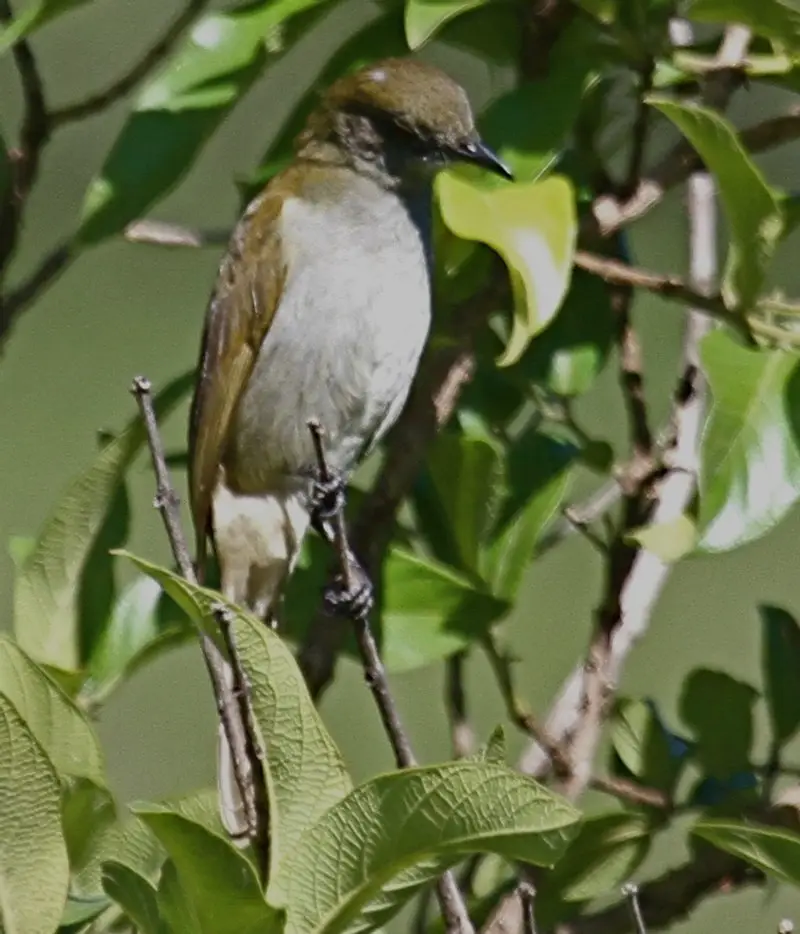
The Slender-billed Greenbul is a species of passerine bird belonging to the Bulbul family, native to western and central Africa. It inhabits subtropical or tropical dry, moist lowland and montane forests.
This small songbird has an olive green plumage with yellowish-green underparts and a long slender bill which it uses for catching insects. Its diet mainly consists of fruits, berries and seeds but will also feed on invertebrates such as beetles, caterpillars and spiders when available.
The Slender-billed Greenbul was formally described in 1854 by John Cassin who noted its distinctive features at that time including its slim bill shape compared to other bulbus species found in the region.
Today this beautiful little bird continues to delight us with its vibrant colors during breeding season when males show off their colorful feathers while singing complex songs from treetops.Scientific classification:
| Kingdom | Animalia |
| Phylum | Chordata |
| Class | Aves |
| Order | Passeriformes |
| Family | Pycnonotidae |
| Genus | Stelgidillas Oberholser, 1899 |
| Species | S. gracilirostris |
12. Western Nicator
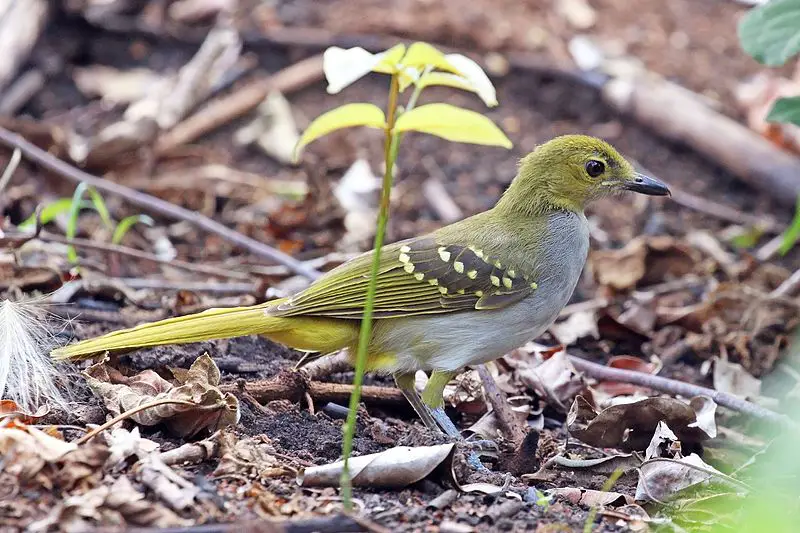
The Western Nicator is a species of songbird belonging to the family Nicatoridae. It has distinctive olive green sides on its face and crown, which makes it easily identifiable from other birds in its range.
This bird typically lives in tropical rainforests or swamps, preferring moist lowland forest habitats for nesting and roosting.
Its vocalizations are also quite distinct compared to other similar species, allowing for quick identification when heard nearby.
In addition to their unique appearance and sound, the Western Nicator offers an interesting sight of beauty with colorful plumage as well as strength demonstrated through long-distance migration patterns during certain times of year.
All together this bird provides an amazing experience that should not be missed.Scientific classification:
| Kingdom | Animalia |
| Phylum | Chordata |
| Class | Aves |
| Order | Passeriformes |
| Family | Nicatoridae |
| Genus | Nicator |
| Species | N. chloris |
13. Blue-Breasted Bee-Eater
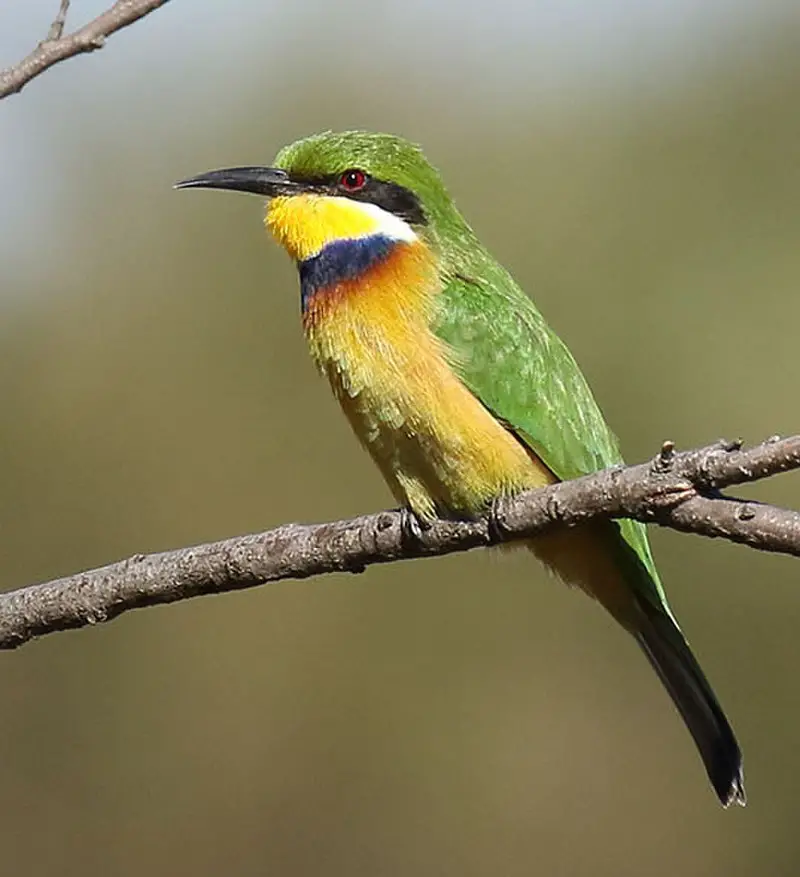
The Blue-breasted Bee-eater (Merops variegatus) is a truly magnificent species of bird found in Central Africa. It belongs to the family Meropidae, which also includes other visually similar birds with specialized diets consisting mainly of Hymenopterans.
This fascinating bird has bright plumage and stands out among its peers due to its large head, short neck and long curved slender beak that allow it to feed on bees and other insects.
Its wings are well developed for strong flight capabilities while its tail helps maintain balance during high speed chases after prey.
The blue-breasted bee-eater is an incredibly beautiful species worth protecting as they play an important role in their natural environment by controlling insect populations.Scientific classification:
| Kingdom | Animalia |
| Phylum | Chordata |
| Class | Aves |
| Order | Coraciiformes |
| Family | Meropidae |
| Genus | Merops |
| Species | M. variegatus |
14. Red-Eyed Puffback
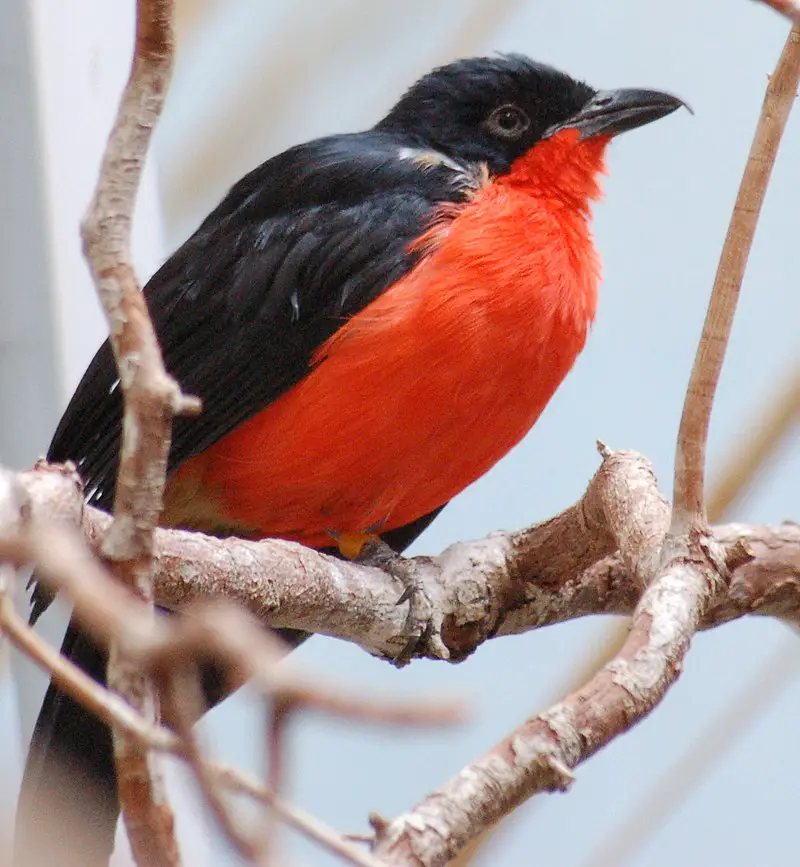
The red-eyed puffback is a species of bird in the family Malaconotidae found mainly in Nigeria and Central Africa. It inhabits areas with subtropical or tropical moist lowland forests, making it an important part of those ecosystems.
This small passerine bird has distinctive bright red eyes, which are framed by its black head feathers.
Its body is a mix of browns and grays while its wings have white patches that can be seen when they’re spread open to fly away from potential predators or as they search for food sources such as insects, seeds or fruit on the ground below them.
The red-eye puffback is also notable for having loud voices used both to communicate within their flock and to ward off enemies – ensuring these birds maintain a presence in their natural habitats well into the future.Scientific classification:
| Kingdom | Animalia |
| Phylum | Chordata |
| Class | Aves |
| Order | Passeriformes |
| Family | Malaconotidae |
| Genus | Dryoscopus |
| Species | D. senegalensis |
15. White-Bibbed Swallow
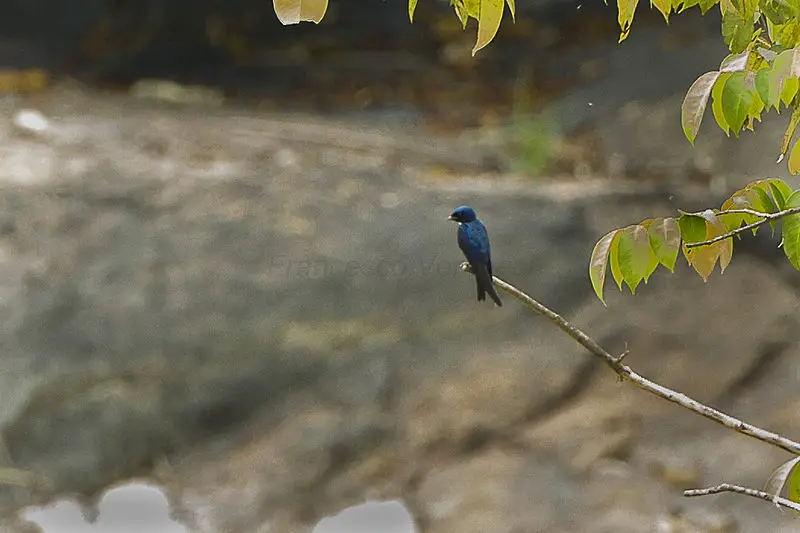
The White-bibbed Swallow is a species of bird found in Central and West Africa. They have an unmistakable appearance, featuring white bibs on their chests that contrast with the blue coloring of their feathers, as well as white throats.
Their diet consists mainly of insects which they catch mid-air while flying.
This species prefers to nest near water sources such as rivers or streams, constructing nests out of mud pellets at least one metre above ground level so they can stay safe from predators like snakes and monitor lizards.
Unfortunately due to deforestation this beloved species faces habitat loss and may become threatened if conservation efforts are not taken soon enough.Scientific classification:
| Kingdom | Animalia |
| Phylum | Chordata |
| Class | Aves |
| Order | Passeriformes |
| Family | Hirundinidae |
| Genus | Hirundo |
| Species | H. nigrita |
16. Lowland Sooty Boubou
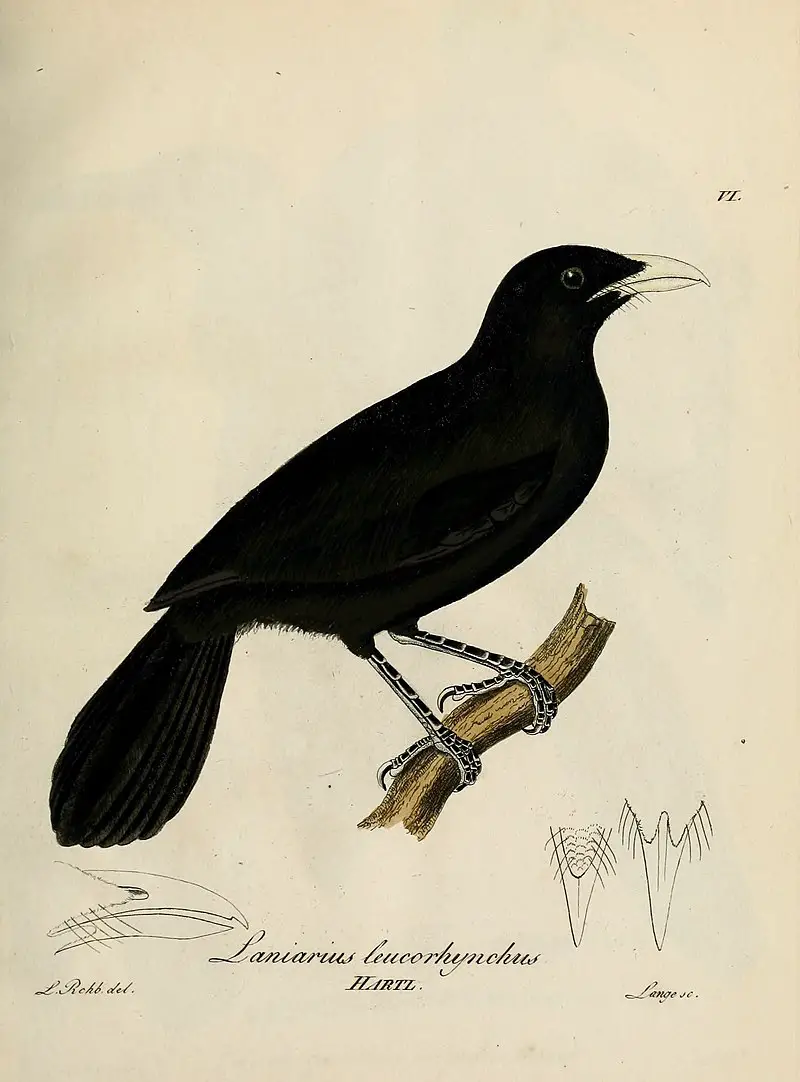
The Lowland sooty boubou is a species of bird found in many parts of Africa. It belongs to the Malaconotidae family and has an impressive range, including Angola, Benin, Cameroon, Central African Republic and more.
These birds have black plumage with white underparts and distinctive long tails that can reach up to twice their body length when spread out wide.
They are monogamous breeders who prefer living in dense forests or thickets where they feed on insects as well as fruits.
The lowland sooty boubou is not currently threatened but its numbers may be declining due to habitat loss caused by deforestation and agricultural activitiesScientific classification:
| Kingdom | Animalia |
| Phylum | Chordata |
| Class | Aves |
| Order | Passeriformes |
| Family | Malaconotidae |
| Genus | Laniarius |
| Species | L. leucorhynchus |
17. Narina Trogon
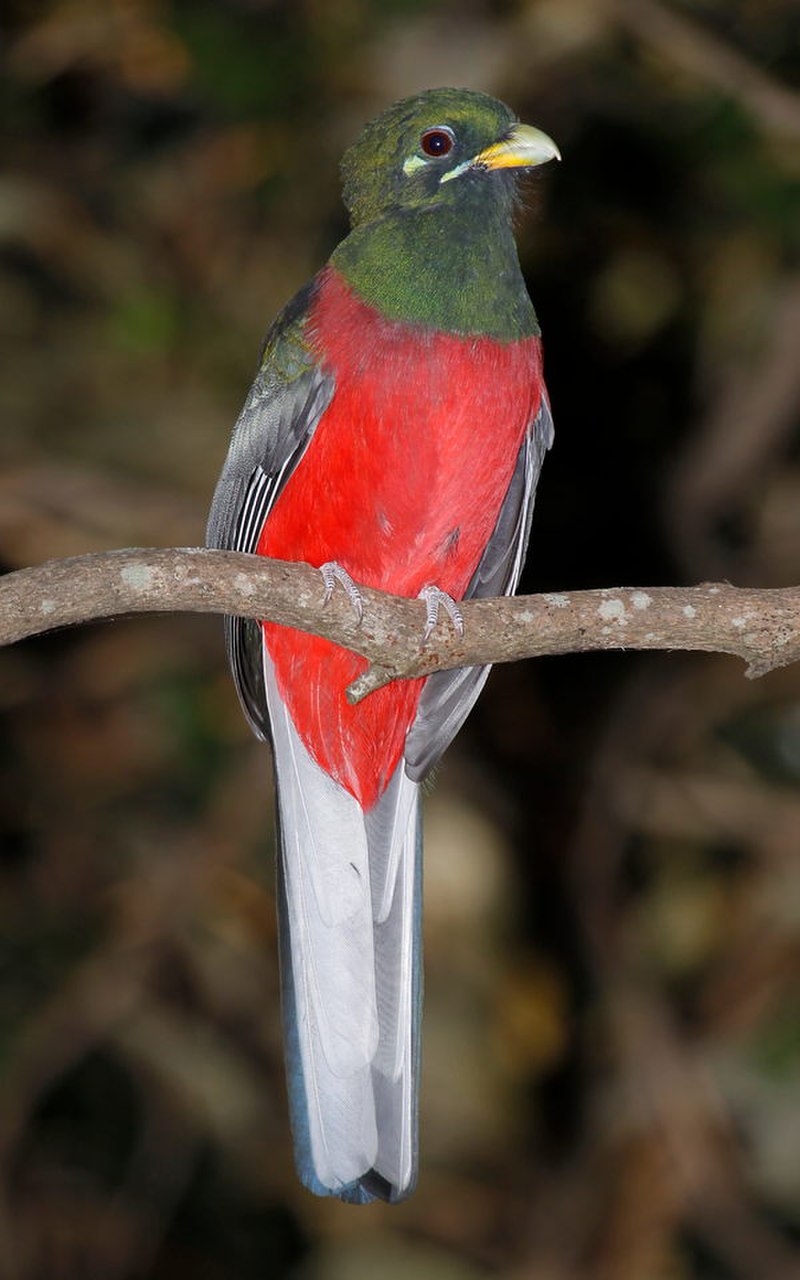
The Narina trogon is a beautiful bird native to forests and woodlands in the Afrotropics. It has a vibrant green head, chestnut neck with white feathers on its throat, bright red underparts and two long tail streamers tipped with black.
An average size of 32-34 cm makes it medium sized among other trogons species.
This highly adaptable species can survive in different environments but local populations have drastically decreased due to deforestation.
Some birds are sedentary while some undertake regular migrations from one place to another making them quite widespread across their range.
The Narina Trogon is an amazing sight for any nature enthusiast as they enjoy fluttering through the forest canopy.Scientific classification:
| Kingdom | Animalia |
| Phylum | Chordata |
| Class | Aves |
| Order | Trogoniformes |
| Family | Trogonidae |
| Genus | Apaloderma |
| Species | A. narina |
18. African Wood Owl
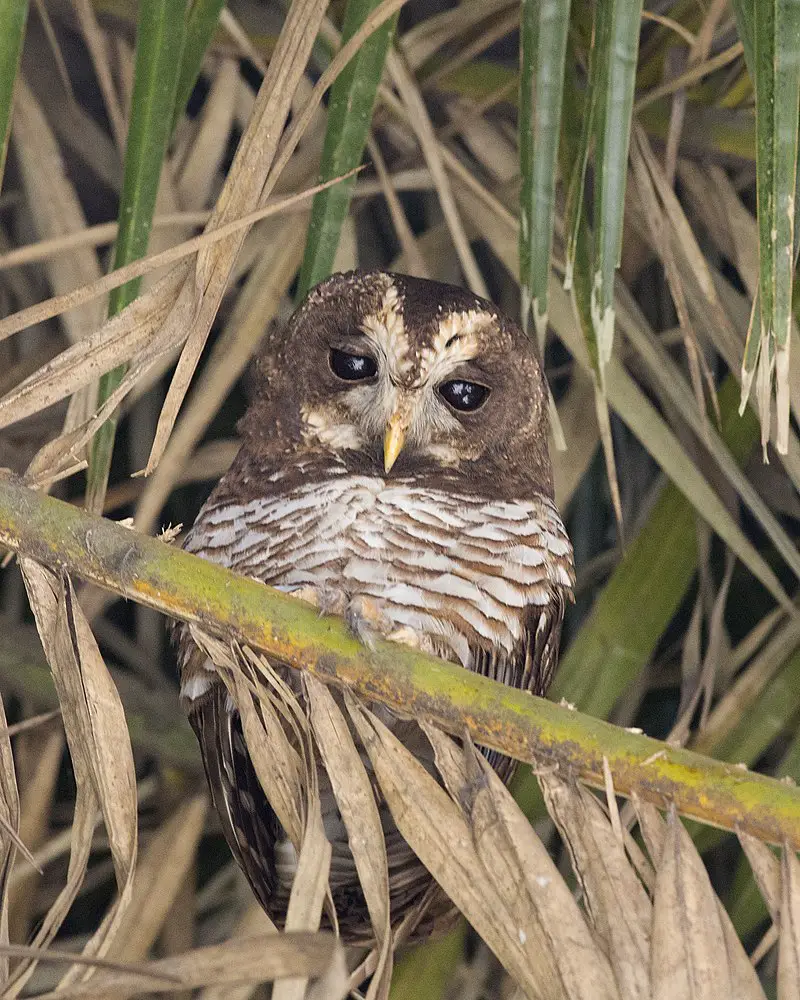
The African wood owl is a medium-sized bird of the genus Strix in the family Strigidae, native to sub-Saharan Africa. It has a typical rounded head with large dark eyes accented by white eyebrows and a white belly barred with brown stripes.
The wings are broad and long while its legs are covered in feathers up to their talons. Its call is described as resembling that of an angry monkey or cat.
It’s nocturnal habit makes it difficult for humans to observe but when seen it usually perches on low branches of trees during daylight hours.
This species feeds mainly on small rodents, birds, reptiles and insects which they hunt at night using hearing rather than sight due to poor vision from bright light conditions.
They typically nest within cavities located in old tree trunks or stumps closeby rivers where there is plenty of cover from dense vegetation nearby allowing them easy access between roosting areas and food sources such as termite moundsScientific classification:
| Kingdom | Animalia |
| Phylum | Chordata |
| Class | Aves |
| Order | Strigiformes |
| Family | Strigidae |
| Genus | Strix |
| Species | S. woodfordii |
19. Black-Casqued Hornbill
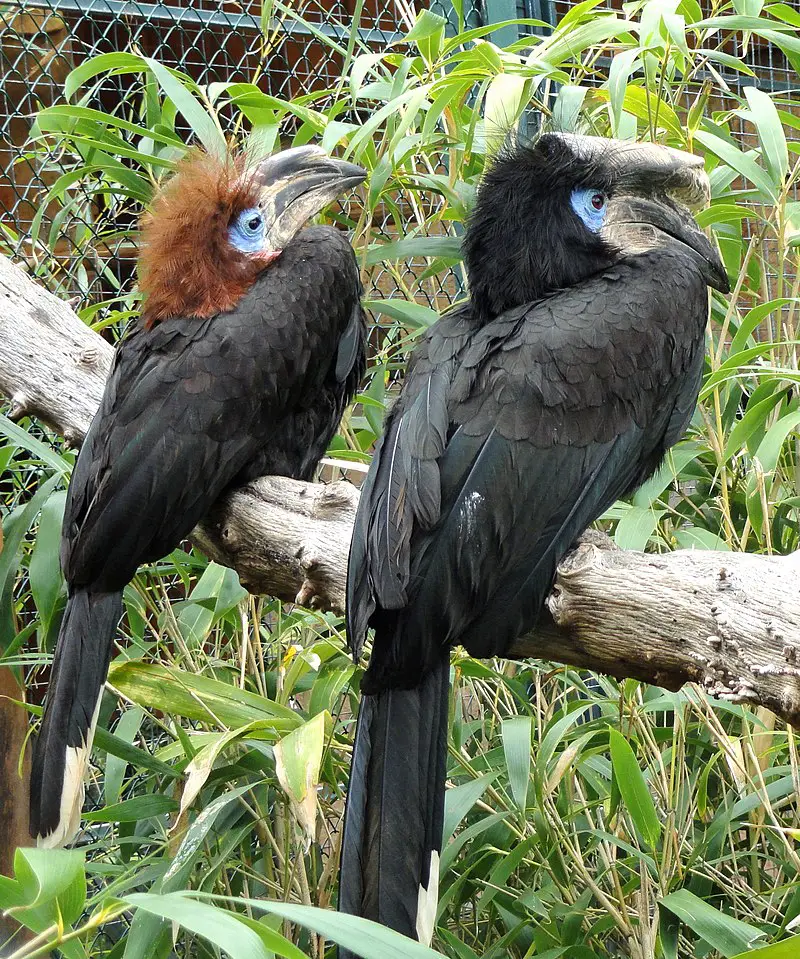
The black-casqued hornbill is a species of bird in the Bucerotidae family, often found across African tropical rainforests.
It has distinctive black casques on its beak and wattles on its throat which gives it an eye-catching appearance.
As with all Hornbills, they have large bills and strong legs for flying long distances to find food – usually insects such as beetles or caterpillars.
They also enjoy eating fruit when they can find them.
The Black-Casqued Wattled Hornbill typically lives alone but during mating season will form small groups consisting of two females and one male; these birds are monogamous so the same couple stay together throughout their life cycle.Scientific classification:
| Kingdom | Animalia |
| Phylum | Chordata |
| Class | Aves |
| Order | Bucerotiformes |
| Family | Bucerotidae |
| Genus | Ceratogymna |
| Species | C. atrata |
20. African Golden Oriole
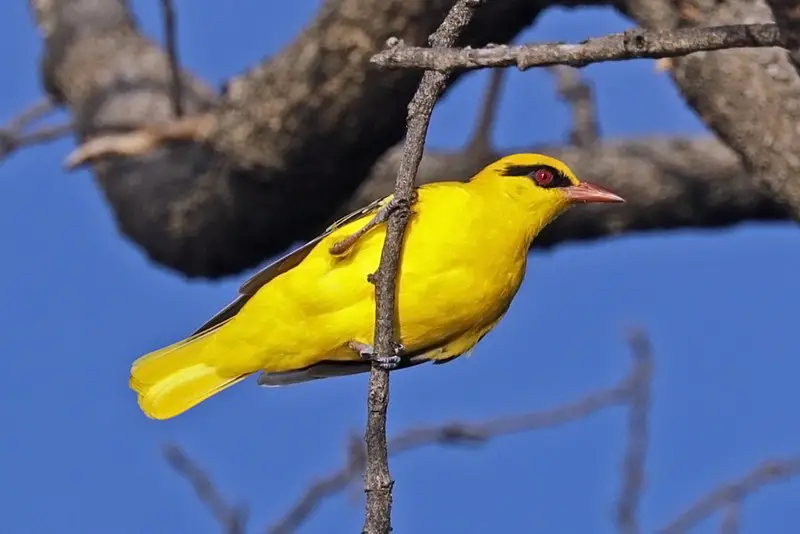
The African golden oriole is a beautiful passerine bird found in Africa south of the Sahara desert. It inhabits thick bushes and other well-wooded areas, building its hanging basket nest in tree branches.
The two eggs it lays are usually white or pale blue with dark spots. Its diet consists mainly of insects and fruit, especially figs which can be found among the high treetops where this species makes its home.
With its striking yellow plumage accented by black wings and tail feathers, this bird stands out amongst others as an exotic yet vibrant creature that instantly captures attention when spotted.Scientific classification:
| Kingdom | Animalia |
| Phylum | Chordata |
| Class | Aves |
| Order | Passeriformes |
| Family | Oriolidae |
| Genus | Oriolus |
| Species | O. auratus |
21. Hartlaub’s Duck
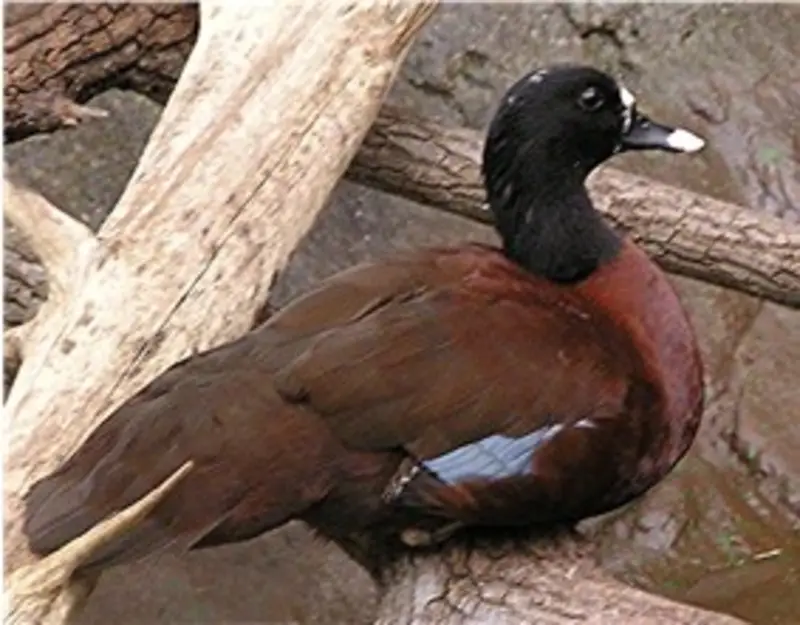
Hartlaub’s duck is a unique species of dark chestnut-coloured bird found in African forests.
It was originally classified as a “perching duck”, but recent genetic analysis has revealed that it actually belongs to the dabbling ducks and therefore occupies its own genus, Pteronetta.
This distinct species differs from other typical dabbling ducks due to its mtDNA sequences of cytochrome b and NA which are different from those seen in most aquatic birds.
Hartlaub’s Duck is an interesting example of how evolutionary processes can create new species over time, even within closely related families.Scientific classification:
| Kingdom | Animalia |
| Phylum | Chordata |
| Class | Aves |
| Order | Anseriformes |
| Family | Anatidae |
| Genus | Pteronetta Salvadori, 1895 |
| Species | P. hartlaubii |
22. Plumed Guineafowl
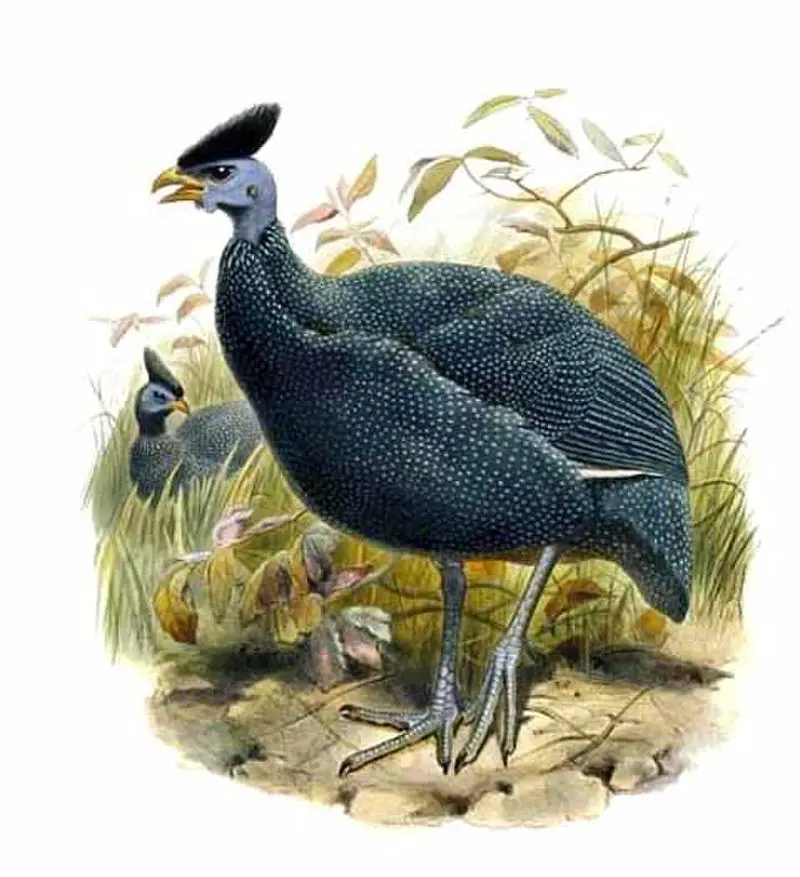
The Plumed Guineafowl is a unique bird that can be found in Central Africa’s humid primary forests. It resembles some subspecies of the crested guineafowl, but has distinct physical characteristics such as its straight and higher crest, and long wattles on either side of its bill.
Its face and neck are covered with dull grey-blue bare skin which sets it apart from other species within the same family.
It feeds mainly on fruits, seeds, insects, worms and small reptiles which it finds while foraging through leaf litter or low vegetation cover near water bodies like streams or pools.
These birds usually live in small flocks consisting of up to 8 individuals, making them highly social creatures who communicate using different calls when they sense danger nearby.
The Plumed Guinea Fowl is an amazing creature whose beauty should be admired by all.Scientific classification:
| Kingdom | Animalia |
| Phylum | Chordata |
| Class | Aves |
| Order | Galliformes |
| Family | Numididae |
| Genus | Guttera |
| Species | G. plumifera |
23. African Paradise Flycatcher
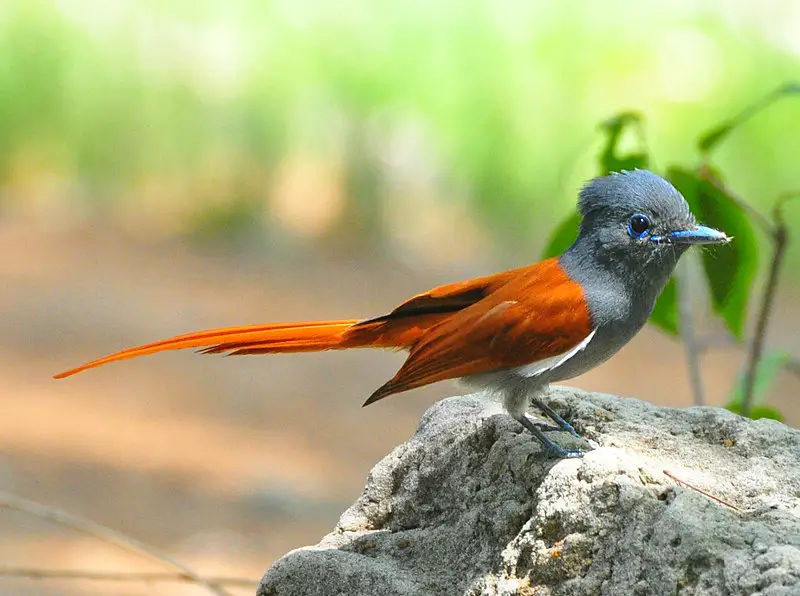
The African paradise flycatcher is a beautiful passerine bird, with the males having tail feathers that extend into streamers twice as long as its body.
Males have chestnut or rusty coloured upper parts on their wings and tails, contrasting nicely against the whitish underparts of both genders.
The head and throat are black for adult males, while females lack this colouration but feature some orange-red streaking instead.
Both sexes bear red eyes and blue-grey legs and feet to round out their appearance.
These birds mainly inhabit tropical forests throughout Sub-Saharan Africa where they feed primarily on insects such as beetles, ants, cicadas; occasionally supplementing it with small fruit when available during certain times of yearScientific classification:
| Kingdom | Animalia |
| Phylum | Chordata |
| Class | Aves |
| Order | Passeriformes |
| Family | Monarchidae |
| Genus | Terpsiphone |
| Species | T. viridis |
24. Pel’s Fishing Owl
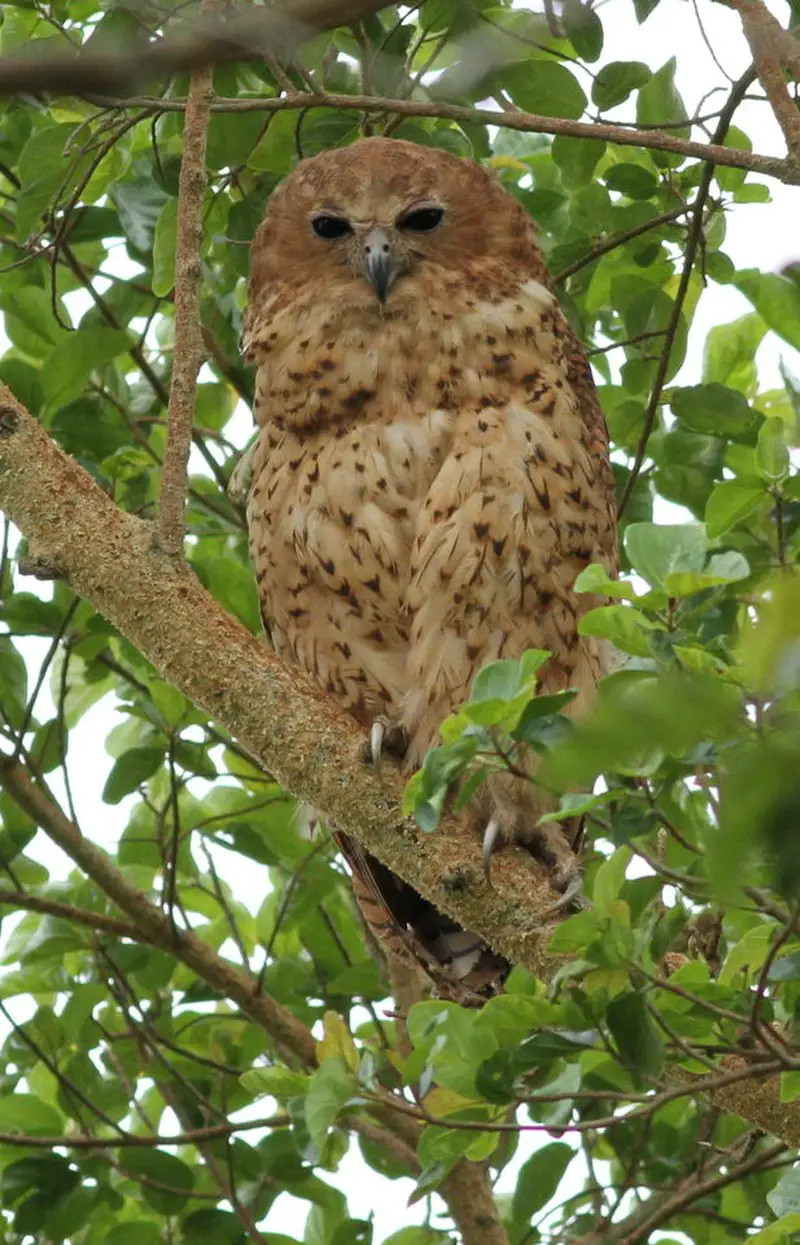
Pel’s fishing owl is a large species of Strigidae found in Africa. It hunts mainly at night, snatching up fish and frogs from rivers and lakes with its sharp talons.
They prefer slow-moving waterways with lots of overhanging trees so they can roost during the day or hunt for prey without being seen.
The owls nest in hollows or forks of large trees to stay safe from predators.
Even though there are many threats that put these birds at risk, conservation efforts have helped secure their population numbers for now.Scientific classification:
| Kingdom | Animalia |
| Phylum | Chordata |
| Class | Aves |
| Order | Strigiformes |
| Family | Strigidae |
| Genus | Scotopelia |
| Species | S. peli |
25. Congo Martin
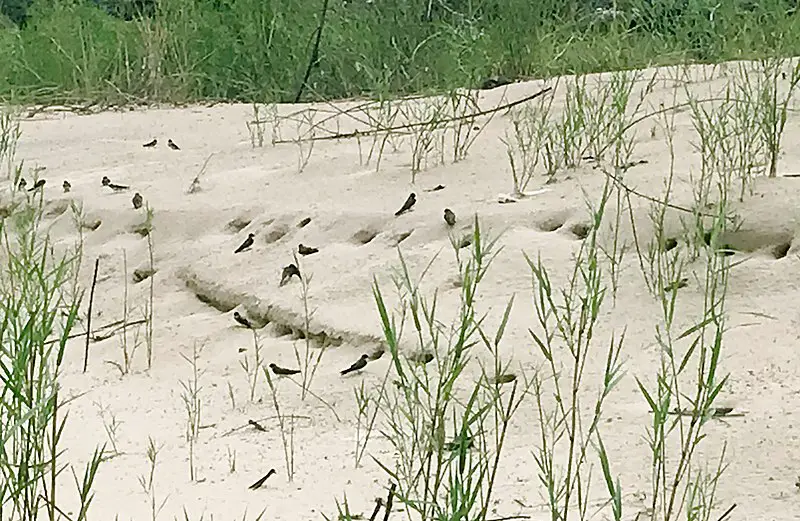
The Congo martin is a small passerine bird belonging to the swallow family. It is found only in limited areas along the Congo River and its tributary, the Ubangi.
This non-migratory species resides in forested rivers with sandbanks for breeding and can be seen fairly abundant within its range during February and March when they form colonies for nesting.
They feed on insects flying over water bodies such as lakes and wetlands or even high up in sky while taking short flights after prey items.
The conservation status of this species has not yet been evaluated by IUCN but their population trend indicates that it may soon need protection from extinction threats like habitat destruction due to human activity amongst others.Scientific classification:
| Kingdom | Animalia |
| Phylum | Chordata |
| Class | Aves |
| Order | Passeriformes |
| Family | Hirundinidae |
| Genus | Riparia |
| Species | R. congica |